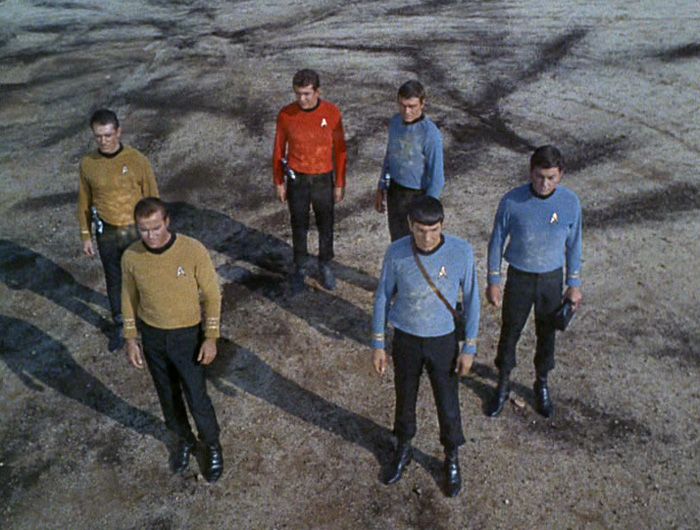So cool to see those "Operation Retrieve" pages up close! I love all these little background details. 


That's an odd analogy. The greeters at my Wal Mart are mostly elderly men and women. They have very little to do with security. I'm gonna assume Starfleet Security has some training in weapons and hand to hand combat and would fair a bit better in a combat situation than a bored semiretired septuagenarian.
And they come in all colorsTRAVERS [OC]: Be sure to bring along your tactical people. I've got an interesting problem for them.
KIRK: We'll beam down immediately, Commodore. Kirk out.
SPOCK: Captain. I wonder why he's insistent that our tactical aides come down.
KIRK: This colony is isolated, exposed, out on the edge of now here. He probably wants additional advice.

Or it's his nickname, like "Ike" or "Monty", or "Bomber" Harris. He's the admiral responsible for Starfleet's war planning, for want of a better term. He's widely derided by his colleagues in the exploratory and scientific fields, and earned himself the somewhat derogatory nickname "Colonel" for his perceived eagerness for military matters. Maybe his grandfather was a well-known MACO colonel in the Romulan War, and he inherited the moniker with his constant bragging of Pop's Rommie-slaughter in his Academy days?Colonel is his first name.
His mother's maiden name was "Styles".Or it's his nickname, like "Ike" or "Monty", or "Bomber" Harris. He's the admiral responsible for Starfleet's war planning, for want of a better term. He's widely derided by his colleagues in the exploratory and scientific fields, and earned himself the somewhat derogatory nickname "Colonel" for his perceived eagerness for military matters. Maybe his grandfather was a well-known MACO colonel in the Romulan War, and he inherited the moniker with his constant bragging of Pop's Rommie-slaughter in his Academy days?
Potemkin was a Constitution as seen in "The Ultimate Computer" (TOS). So if anything, the smaller icons would represent ships smaller than that. However, I'm not sure we should assume they are in fact to scale, because on the preceding page Emden is shown with an icon the same size as Potemkin. The different sizes might indicate different roles in the mission or something, like maybe Excelsior and Potemkin are to take the lead with Eagle in support of them, and Endeavour standing by to take the lead with Emden and Ahwahnee in support if something should go wrong. But there's certainly plenty of room for speculation in interpreting the chart.In the top image, we see starships of varying sizes. Assuming these are to scale with the actual ships, the Potempkin icon looks to be almost the same size as Excelsior, while the Eagle is smaller (similar to the size of a Constitution class). These size differences are again indicated in the side key showing the Endeavour et al. So, like the background videos in STiD, this Starfleet has ships of similar design but varying scales.
Yes indeed, and I'm sure that was the intention. Oberth is probably the prototype of that class as well, although being not as new has gone from NX to NCC, as Excelsior did between STIII and STVI. Lantree was later (in-universe) seen still in use as a supply ship in "Unnatural Selection" (TNG).In the bottom image, the USS Constellation is listed as NX-1974. One might imagine this is the prototype of the Constellation class (it did look to be of the TOS movie era).
USS Whorfin NCC-1024 must be a sister ship of USS Discovery!
It's going to Planet 10.USS Whorfin NCC-1024 must be a sister ship of USS Discovery!
Potemkin was a Constitution as seen in "The Ultimate Computer" (TOS). So if anything, the smaller icons would represent ships smaller than that.
Starfleet security officers would be roughly the equivalent to security personnel in modern military. And the average Wal-Mart door greeter probably wouldn't last among them.I find it extremely unlikely they are the normal garden-variety Starfleet Security. That's for security guards on board ship - the redshirts from TOS. It would be no more appropriate to send such redshirts into ground engagements than it would to take a door greeter at Walmart and send him to Afghanistan.
I'd further argue that "Starship Security" comes in several tiers. This is the force with which Picard has to wage his ground campaigns, so there are top professionals there - but the force also gets bolstered by LaForge's engineers in times of need, so there are rank amateurs there as well. Just as in any army today, really: the cannon fodder is barely trained, perhaps even freshly conscripted, but not just the top officers but also some of the actual "line fighters" (in special operations forces) are extremely well-trained warriors.
Whenever we see Kirk's redshirts fumble and bleed, we can say "Ah, one of the reinforcements!". Whenever one puts up a competent fight, such as against Decker in "Doomsday Machine", we can say "Heh, one of 'em Starfleet Rangers!". It would only be in massed ground action that we could readily distinguish between the two (or more) types, though, and see them used in roles best befitting their training levels.
Timo Saloniemi
It's going to Planet 10.
We use essential cookies to make this site work, and optional cookies to enhance your experience.
